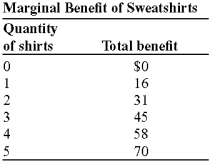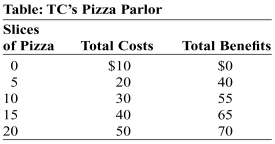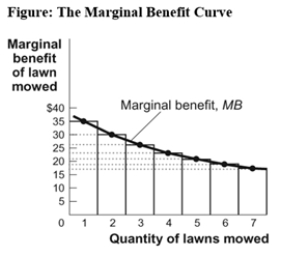A) has a hard time recognizing losing investments and moving on.
B) is likely to maximize total revenue rather than profit.
C) is unlikely to ignore sunk costs.
D) is more likely to use a credit card than to pay cash.
Correct Answer

verified
Correct Answer
verified
Multiple Choice
The willingness to sacrifice some economic payoff to avoid a potential loss is:
A) irrational behavior.
B) bounded rationality.
C) the result of a concern about fairness.
D) risk aversion.
Correct Answer

verified
Correct Answer
verified
Multiple Choice
In general,when marginal benefit is greater than marginal cost,the decision maker should do _____ of the activity.
A) less
B) that exact amount
C) more
D) none
Correct Answer

verified
Correct Answer
verified
Multiple Choice
The _____ benefit is the amount by which an additional unit of an activity increases its total benefit.
A) average
B) net
C) marginal
D) top
Correct Answer

verified
Correct Answer
verified
True/False
If the marginal cost of any activity is constant at $4,then at the optimal quantity of the activity,the marginal benefit will be $4.
Correct Answer

verified
Correct Answer
verified
Multiple Choice
Accountants use only _____ costs in their computations of short-run total cost.
A) opportunity
B) implicit
C) explicit
D) variable
Correct Answer

verified
Correct Answer
verified
Multiple Choice
Suppose Bob has a part-time business washing cars.He has washed nine cars on a given day;the marginal benefit of washing the tenth car is $20 and the marginal cost is $12.Bob should:
A) wash the tenth car.
B) not wash the tenth car.
C) increase his marginal benefit.
D) There is not enough information to decide.
Correct Answer

verified
Correct Answer
verified
Multiple Choice
Lucy bought some stock 10 years ago that has been priced at half of her purchase price for the past 5 years.However,Lucy refuses to sell the stock,thinking that,if she waits long enough,she will recover her investment.What type of behavior does this represent?
A) mental accounting
B) bounded rationality
C) risk aversion
D) loss aversion
Correct Answer

verified
Correct Answer
verified
Multiple Choice
If the marginal benefit received from consuming a good is equal to the marginal cost of production:
A) society's well-being cannot be improved by changing production.
B) society's well-being can be improved if production decreases.
C) society's well-being can be improved if production increases.
D) the market is producing too much of the good.
Correct Answer

verified
Correct Answer
verified
Multiple Choice
Expenses associated with factors of production may be _____ costs.
A) implicit
B) opportunity
C) explicit
D) implicit,opportunity,or explicit
Correct Answer

verified
Correct Answer
verified
True/False
Marginal analysis should be used in "either-or" decisions.
Correct Answer

verified
Correct Answer
verified
Multiple Choice
If the accounting profit for a firm is negative,the:
A) economic profit must be positive.
B) economic profit must be negative.
C) firm should produce more.
D) firm will not owe any taxes.
Correct Answer

verified
Correct Answer
verified
Multiple Choice
As George ate pizza during one recent outing,he found that he enjoyed each additional slice less and less.This implies that his marginal benefit was:
A) decreasing.
B) increasing.
C) constant.
D) vertical.
Correct Answer

verified
Correct Answer
verified
Multiple Choice
Use the following to answer question:  -(Table: Marginal Benefit of Sweatshirts) Use Table: Marginal Benefit of Sweatshirts.The marginal benefit of producing the second sweatshirt is:
-(Table: Marginal Benefit of Sweatshirts) Use Table: Marginal Benefit of Sweatshirts.The marginal benefit of producing the second sweatshirt is:
A) $31.
B) $16.
C) $15.
D) $14.
Correct Answer

verified
Correct Answer
verified
Multiple Choice
Use the following to answer question:  -(Table: TC's Pizza Parlor) Use Table: TC's Pizza Parlor.Assume that marginal cost is constant in the intervals of production.The marginal cost for pizza production:
-(Table: TC's Pizza Parlor) Use Table: TC's Pizza Parlor.Assume that marginal cost is constant in the intervals of production.The marginal cost for pizza production:
A) remains constant.
B) increases,then decreases.
C) increases.
D) decreases.
Correct Answer

verified
Correct Answer
verified
Multiple Choice
Costs that are included in the economic concept of cost but that are NOT explicit costs are:
A) outlay costs.
B) accounting profits.
C) implicit costs.
D) economic profits.
Correct Answer

verified
Correct Answer
verified
Multiple Choice
An "either-or" decision entails:
A) deciding how much of an activity to do.
B) a choice between two activities.
C) calculating marginal costs for each activity.
D) calculating the marginal benefits for each activity.
Correct Answer

verified
Correct Answer
verified
Multiple Choice
Profit computed without implicit costs is _____ profit.
A) explicit
B) accounting
C) implicit
D) economic
Correct Answer

verified
Correct Answer
verified
Multiple Choice
Mary goes ahead and buys a new car because she expects to receive a 10% increase in her salary next year.What type of behavior does this BEST represent?
A) status quo bias
B) overconfidence
C) misperception of opportunity costs
D) risk aversion
Correct Answer

verified
Correct Answer
verified
Multiple Choice
Use the following to answer question:  -(Figure: The Marginal Benefit Curve) Use Figure: The Marginal Benefit Curve.The total benefit of mowing six lawns is approximately:
-(Figure: The Marginal Benefit Curve) Use Figure: The Marginal Benefit Curve.The total benefit of mowing six lawns is approximately:
A) $19.
B) $35.
C) $154.
D) $200.
Correct Answer

verified
Correct Answer
verified
Showing 121 - 140 of 186
Related Exams